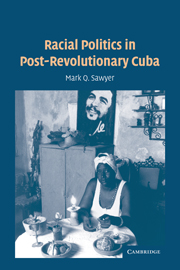Book contents
- Frontmatter
- Contents
- List of Figures and Tables
- Acknowledgments
- Introduction
- 1 Race Cycles, Racial Hierarchy, and Inclusionary Discrimination: A Dynamic Approach
- 2 Freedom and Discrimination: Uneven Inequality and Inclusion in Pre-Revolutionary Cuba
- 3 Race and Revolution: Transformation and Continuity
- 4 Match Made in Heaven or Strange Bedfellows? Black Radicals in Castro's Cuba
- 5 Race and Daily Life in Cuba During the Special Period: Part I: Interview Data
- 6 Race and Daily Life in Cuba During the Special Period: Part Ⅱ: Survey Research
- 7 Racial Politics in Miami: Ninety Miles and a World Away
- Conclusion
- Bibliography
- Index
1 - Race Cycles, Racial Hierarchy, and Inclusionary Discrimination: A Dynamic Approach
Published online by Cambridge University Press: 05 September 2012
- Frontmatter
- Contents
- List of Figures and Tables
- Acknowledgments
- Introduction
- 1 Race Cycles, Racial Hierarchy, and Inclusionary Discrimination: A Dynamic Approach
- 2 Freedom and Discrimination: Uneven Inequality and Inclusion in Pre-Revolutionary Cuba
- 3 Race and Revolution: Transformation and Continuity
- 4 Match Made in Heaven or Strange Bedfellows? Black Radicals in Castro's Cuba
- 5 Race and Daily Life in Cuba During the Special Period: Part I: Interview Data
- 6 Race and Daily Life in Cuba During the Special Period: Part Ⅱ: Survey Research
- 7 Racial Politics in Miami: Ninety Miles and a World Away
- Conclusion
- Bibliography
- Index
Summary
This book has two agendas: (1) to use the case of Cuba to examine why racial politics change and what limits the amount of improvement for subordinate racial groups and (2) to analyze racial politics in modern Cuba empirically in the context of theories that have been used to explain racial politics in Cuba specifically and in Latin America generally. It is tempting to believe that a single underlying narrative can be found to explain racial politics in post-revolutionary Cuba. The central argument of this book, however, is that at the level of both state and individual, there are often contradictory forces at work with regard to racial politics. Mechanisms of racial change have a strange duality, as they can simultaneously create greater racial equality and reinforce ideas that maintain racial hierarchy. One such mechanism is the myth of color-blindness, which has become a dominant discourse of modern nation states, including Brazil, Cuba, and later the United States (Guinier and Torres 2002).
The contradictory forces at work in racial politics have been expressed in Cuba through its history, state policy, culture, and racial ideology, and in the everyday experiences of Cubans. There has been no linear improvement in racial politics, but an iterative process of opening and closure that has been limited by racial ideology. This book explores all of these elements and their individual, varied effects on racial politics in postrevolutionary Cuba. I look first at broad historical elements and then at the day-to-day situation on the island.
- Type
- Chapter
- Information
- Racial Politics in Post-Revolutionary Cuba , pp. 1 - 35Publisher: Cambridge University PressPrint publication year: 2005

